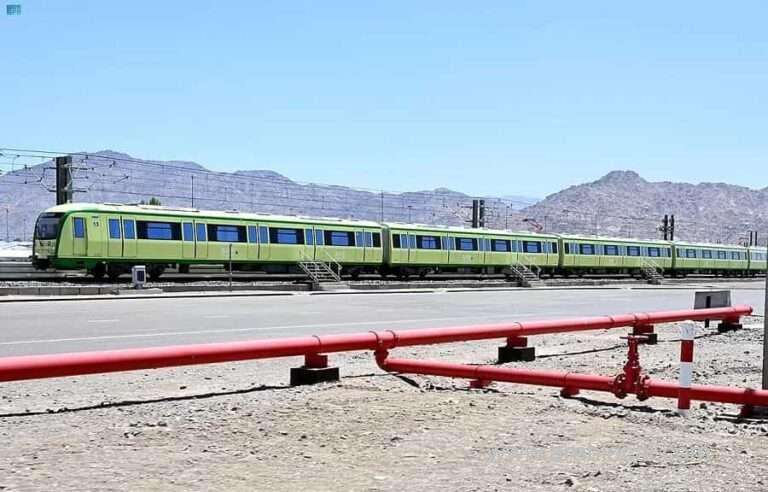The Al-Mashaaer Train at the Holy Sites of Makkah is one of Saudi Arabia's most famous pilgrimage projects in the last 15 years. The project received the Franz Edelman Award for the finest operational and applied research.
A survey conducted by the International Federation of Engineering Consultants ranked the Al-Mashaer Metro Line among the top 24 international initiatives of the last century.
– The Al-Mashaer high-speed electric train, introduced in November 2010, is intended to transport pilgrims between the Holy Sites of Mina, Arafat, and Muzdalifah during the Hajj season each year.
- The Al-Mashaer train operates only 7 days a year, serving only Hajj pilgrims during the Hajj season. This train has the highest capacity of any metro in the world.
– Nine stations stretch along the 18-kilometer railway, with three stations each in Arafat, Muzdalifah, and Mina. The final station is close to the Jamarat Bridge. The trip from Mina to Arafat takes the train around 20 minutes at an average speed of 80 km/h.
– The nine stops were built with a number of considerations to help pilgrims travel more easily when entering the stations, boarding the train, and getting off. The waiting room and boarding area, as well as the boarding platform and departure platform, were divided to handle the high number of pilgrims that board the Al-Mashaer train.
– In addition to electric lifts designed to make it easier for pilgrims to enter and exit the station, particularly the elderly and people with disabilities, the Al-Mashaer train stations also have connecting bridges for getting people to the ground floor of the station from the opposite side and ramps for getting people off the station platform.
– The design of the stations also considered the 60 entry and exit doors that the train has on each side. Where there are an equal number of doors in each station to facilitate easy access and exit by pilgrims while travelling on the train.
– In addition to making it easier for this large number of pilgrims to arrive and perform various rituals in a short amount of time compared to other modes of transportation, the Al Mashaer train helps transport hundreds of thousands of pilgrims during each of its various movements between the attachments. The presence of the train also helps to remove nearly 50,000 passenger buses from the roads during the Hajj season. As a result, there is less traffic congestion and carbon emissions are reduced.
– The Al-Mashaer train is one of the most environmentally friendly trains, as it is powered by electricity. This makes its carbon emissions zero, and contributes to preserving the environment at the holy sites and the public health of Hajj pilgrims.
- The Holy Sites are served by 17 trains, each with 12 air-conditioned carriages, each with 5 doors for boarding and alighting 250 passengers. Each train can carry 3,000 people in all its carriages. The total capacity is up to 72,000 passengers per hour because seating can accommodate 20% of the entire number of passengers.
– Al-Mashaer train will be operated by nearly 20,000 operators from various departments and specialists. This train is only used for Hajj, it will not link with future Makkah Metro. The train aims to reduce traffic congestion during the Hajj season.
– The train made 2,170 journeys carrying 2.3 million passengers during the Hajj season in 2019 (1440 AH). The railway suspended operations during the COVID-19 epidemic in 2020-2021, however it resumed operations in 2022, carrying 1.35 million passengers on 2,228 trips. Read : Elderly Pakistani man who went viral on Social media, offered free Hajj
– This year 2023 (1444 AH), the Al-Mashaer train is preparing to transport about 2 million pilgrims during the current season. The Railways Corporation (SAR) launched the pre-trial operation phase of the Holy Sites for the pilgrimage season.
– The trial phase lasted for 30 days, during which systems and equipment in the trains and the operation and control center were tested and evaluated.
– This was after the launch of trial operation of the train. This will last for 60 days, continuing in Shawwal and Dhu Al-Qadah, during which the trains will be prepared and operated gradually, leading to full operation.
– The seasonal work journey began with qualifying and training seasonal workers by attracting 90,000 applications for seasonal jobs. This included 5000 experienced people who worked on the Al-Mashaer Train in the last years, employing about 7,500 employees.





